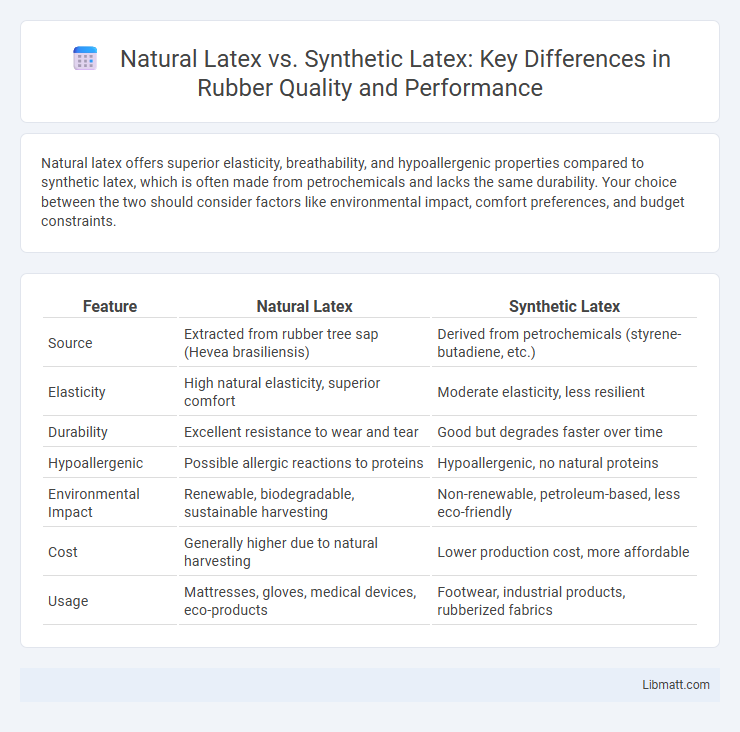Natural latex offers superior elasticity, breathability, and hypoallergenic properties compared to synthetic latex, which is often made from petrochemicals and lacks the same durability. Your choice between the two should consider factors like environmental impact, comfort preferences, and budget constraints.
Table of Comparison
| Feature | Natural Latex | Synthetic Latex |
|---|---|---|
| Source | Extracted from rubber tree sap (Hevea brasiliensis) | Derived from petrochemicals (styrene-butadiene, etc.) |
| Elasticity | High natural elasticity, superior comfort | Moderate elasticity, less resilient |
| Durability | Excellent resistance to wear and tear | Good but degrades faster over time |
| Hypoallergenic | Possible allergic reactions to proteins | Hypoallergenic, no natural proteins |
| Environmental Impact | Renewable, biodegradable, sustainable harvesting | Non-renewable, petroleum-based, less eco-friendly |
| Cost | Generally higher due to natural harvesting | Lower production cost, more affordable |
| Usage | Mattresses, gloves, medical devices, eco-products | Footwear, industrial products, rubberized fabrics |
Introduction to Natural and Synthetic Latex
Natural latex is derived from the sap of rubber trees, offering a biodegradable and eco-friendly material known for its breathability and resilience. Synthetic latex is produced from petrochemicals, providing greater consistency, affordability, and resistance to allergens and dust mites. Understanding these fundamental differences helps you make an informed choice based on comfort, durability, and environmental impact.
What is Natural Latex?
Natural latex is a biodegradable material harvested from the sap of rubber trees (Hevea brasiliensis), valued for its elasticity, durability, and hypoallergenic properties. It contains proteins, lipids, and carbohydrates, contributing to its resilience and breathability, making it a preferred choice for eco-friendly mattresses and pillows. Unlike synthetic latex, which is derived from petrochemicals, natural latex offers superior comfort and environmental benefits due to its renewable source.
What is Synthetic Latex?
Synthetic latex is a man-made material produced from petrochemicals, designed to mimic the properties of natural latex but with greater consistency and durability. It is primarily composed of styrene-butadiene rubber (SBR), offering high resistance to wear, moisture, and mildew, making it ideal for applications such as mattresses, gloves, and adhesives. Your choice between natural and synthetic latex depends on factors like allergy sensitivity, environmental impact, and desired product performance.
Key Differences Between Natural and Synthetic Latex
Natural latex is derived from the sap of rubber trees, offering high elasticity, durability, and eco-friendliness, whereas synthetic latex is produced from petrochemicals, generally resulting in less resilience and environmental impact. The protein content in natural latex can cause allergies, a concern not typically associated with synthetic latex due to its chemical composition. Natural latex mattresses often provide superior breathability and biodegradability compared to synthetic options, which excel in cost-effectiveness and uniformity of material properties.
Environmental Impact Comparison
Natural latex is harvested from rubber trees and is biodegradable, making it an eco-friendly option with a lower carbon footprint and reduced environmental pollution compared to synthetic latex. Synthetic latex, derived from petrochemicals, involves energy-intensive manufacturing processes that contribute to higher greenhouse gas emissions and non-biodegradable waste. Choosing natural latex supports sustainable forestry practices and minimizes long-term ecological damage linked to landfill accumulation and resource depletion.
Durability and Longevity
Natural latex offers superior durability and longevity compared to synthetic latex due to its organic composition and resilient cellular structure, often lasting 10-15 years without significant sagging. Synthetic latex, made from petrochemicals, tends to degrade faster, typically lasting around 5-7 years, and may lose its supportive qualities more quickly. Choosing natural latex ensures your mattress or pillow maintains its comfort and support over time, providing better long-term value.
Health and Allergy Considerations
Natural latex, derived from rubber tree sap, is hypoallergenic and resistant to dust mites, mold, and mildew, making it ideal for allergy sufferers and individuals with respiratory sensitivities. Synthetic latex, made from petrochemicals, may contain chemical additives that can trigger allergic reactions or skin irritations in sensitive individuals. Choosing natural latex supports better indoor air quality and reduces the risk of allergens commonly found in synthetic alternatives.
Cost Comparison: Natural vs Synthetic Latex
Natural latex typically costs more than synthetic latex due to its renewable harvesting process and eco-friendly properties. Synthetic latex, made from petrochemicals, offers a more budget-friendly option but lacks the same durability and breathability as natural latex. Your choice between natural and synthetic latex will largely depend on balancing initial investment with long-term comfort and environmental impact.
Ideal Applications for Each Type
Natural latex, derived from rubber tree sap, excels in applications requiring hypoallergenic properties, breathability, and eco-friendliness, making it ideal for mattresses, pillows, and cushioning in organic bedding. Synthetic latex, produced from petrochemicals, offers enhanced durability, consistent density, and cost-effectiveness, suiting industrial uses such as automotive parts, adhesives, and waterproof coatings. Each type's unique characteristics determine their suitability for either comfort-focused or high-performance, heavy-duty applications.
How to Choose the Right Latex for You
Choosing the right latex depends on factors like durability, comfort, and environmental impact. Natural latex, made from rubber tree sap, offers superior breathability, hypoallergenic properties, and eco-friendliness, making it ideal for those prioritizing sustainability and health. Synthetic latex, derived from petrochemicals, tends to be more affordable and resistant to wear but lacks the natural resilience and eco-benefits, so consider your preferences for comfort, budget, and environmental responsibility when selecting your latex.
Natural Latex vs Synthetic Latex Infographic

 libmatt.com
libmatt.com